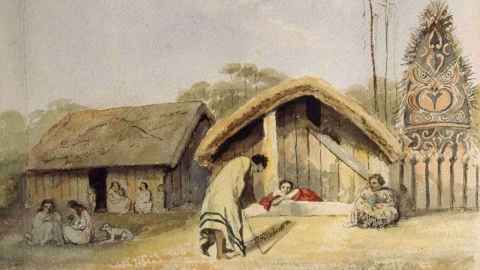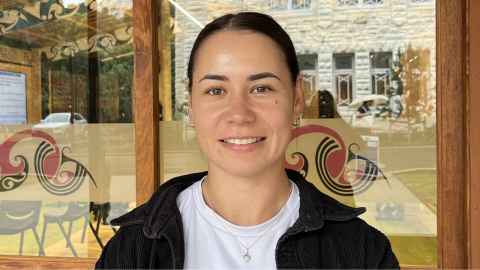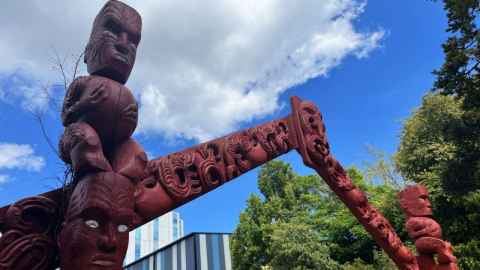Māori solutions to the housing crisis
29 May 2025
Analysis: Māori communities planning to build in traditional ways face overwhelming barriers, says doctoral candidate Savannah Brown.

There’s a wall many iwi and hapū hit before any walls go up on papakāinga, or traditional Māori housing developments.
As an architectural graduate working for an Auckland firm specialising in Māori architectural projects, I discovered the massive barriers to traditional building projects.
Māori building tikanga, materials and techniques are not included in the building laws and codes that were imposed soon after European settlers arrived in Aotearoa.
European building rules overthrew the rules tangata whenua had before the 1820s, when 100 percent of Māori owned their own homes, which were built by Māori.
It was one system fits all approach, and Māori had no option but to comply.
The main impacts of having British laws imposed is our buildings and spaces today don’t reflect how our ancestors were building.
My aspiration is for traditional Māori building practices to become part of our building code, for them to be acknowledged and utilised.
Researching for my PhD in MĀPIHI – Māori and Pacific Housing Research Centre, I realised many iwi and hapū groups wanting to develop or expand papakāinga don’t even get to the design stage.
I talked with four papakāinga groups within the Ngāti Whātua rohe, between Auckland and Whangārei Harbour, and learned the main barriers they face are funding and navigating the complex building code and resource consent processes.
The rigid requirements of building legislation means consultants and engineers must be brought in, all adding to project costs - to the point dreams of developing papakāinga can seem almost impossible to achieve.

The four papakāinga included in my research range in size from four whare or units to more than 50, with some in rural and some in urban environments.
All four groups had aspirations to grow or renovate their papakāinga, but were struggling to make headway in the battle against red tape and the costs it imposes.
The same barriers to building are likely to be faced by iwi around the country.
Before European colonisation, Māori had governing systems guiding how land was laid out and processes for bringing a building to life. There has been a great loss of knowledge and building practices for us as Māori.
However, a few older Māori still hold memories that can be woven into future designs. I talked with a kaumatua in his eighties, who remembered living in a papakāinga when it had traditional long drop toilets, with mānuka screens for privacy.
Over the past 180 years, increasingly restrictive layers of building laws and codes have imposed European values and requirements on Māori.
In 1842, the British colonial government introduced the first building regulation, the Raupō Houses Ordinance. It imposed a tax on buildings constructed of raupō, nīkau and toitoi. Māori traditionally used these materials for thatching for rooves and insulation for walls, but the colonial government said they posed an excessive fire risk.
Some historians have speculated the raupō ban was less about flammability than the British fearing the settlers might choose to live in whare built by Māori, instead of more expensive European-style housing.
Traditionally, Māori cooking fires were in outdoor structures, away from the sleeping area, while indoor fires burned in small pits for warmth and posed little risk of setting the whare on fire.

From 1842 on, Māori were forced to innovate with what was available, blending ancestral knowledge with imposed Western materials.
The first City of Auckland Building Act came into force in 1854, one of the regional predecessors for the national 2004 Building Act.
In the past, housing was available to all, but now an estimated 40 percent of homeless people are Māori. This disproportionate figure signals the impacts of lost traditions and lost land.
The 2023 Census showed just 27.5 percent of Māori owned or partly owned their own home, compared to 66 per cent of all New Zealanders.
The Māori home ownership rate has been steadily falling – it was 31.2 percent in 2013.
A third of Māori lived in homes that were sometimes or always damp and more than 20 percent of Māori lived in crowded homes in 2023.
It’s time to weave tikanga and wairua into our houses again. It’s time for Māori and Pakeha to work in partnership to update building legislation to recognise and include traditional Māori building practices.
The history of Māori in Aotearoa makes us unique. But right now, that history is not reflected in our building code and in our built environments.
That needs to change, so Māori can realise our dreams of being able to house our people in a way that connects past and future.
Analysis by Savannah Brown, who is of Ngāti Whātua, Ngāti Wai, Ngāti Hine, and Ngāpuhi. She is a PhD researcher in MĀPIHI – Māori and Pacific Housing Research Centre at the University of Auckland, Waipapa Taumata Rau, and an assistant teacher on the Waipapa Taumata Rau course.
This article reflects the opinion of the authors and not necessarily the views of Waipapa Taumata Rau, University of Auckland.
This story was first published in The Post on 26 May: Allowing a Māori solution to the Māori housing crisis.
Media contact
Rose Davis | Research communications adviser
M: 027 568 2715
E: rose.davis@auckland.ac.nz